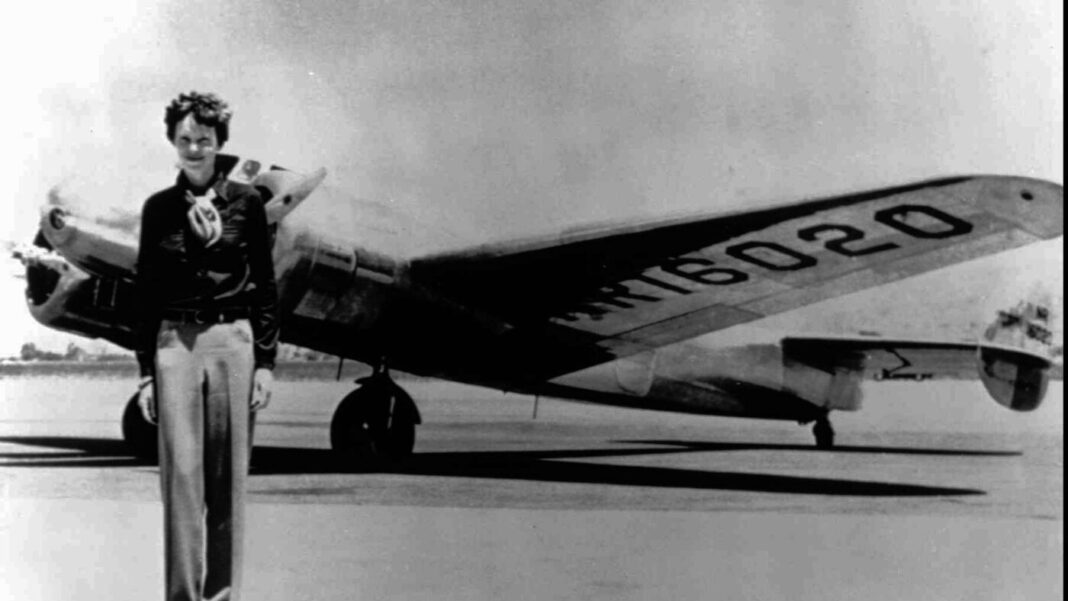
Amelia Earhart stands next to her Lockheed Electra 10E, before her last flight in 1937 from Oakland, Calif., bound for Honolulu. Her disappearance remains one of aviation’s biggest mysteries.
Uncredited/AP
hide caption
toggle caption
Uncredited/AP
A deep sea exploration company that teased a possible clue into Amelia Earhart’s disappearance now says that the underwater image it released earlier this year doesn’t show the wreckage of her aircraft as it had hoped, but a coincidentally plane-shaped natural rock formation.
South Carolina-based company Deep Sea Vision announced in January that it had captured sonar images of what might be Earhart’s Lockheed Electra at the bottom of the Pacific Ocean — about 100 miles off Howland Island, where she and her navigator, Fred Noonan, were supposed to refuel in July 1937 during their quest to circumnavigate the globe.
The two never arrived, and neither their bodies nor the plane wreckage were ever recovered. Earhart was declared dead in 1939.
The disappearance of the 39-year-old — who, if successful, would have been the first female pilot to fly around the world — remains one of aviation’s biggest mysteries to this day.
Deep Sea Vision is the latest in a long line of explorers who have set out to try to find answers.
The company used a high-tech unmanned underwater drone and a 16-member crew to survey more than 5,200 miles of ocean floor in late 2023. It announced earlier this year that one of its sonar images had captured what it believed could be Earhart’s plane.

Deep Sea Vision announced earlier this year that it believed it had snapped a sonar photo of Earhart’s plane, based on its size, shape and location.
Hand-out/Deep Sea Vision/PRNewsfoto/Deep Sea Vision
hide caption
toggle caption
Hand-out/Deep Sea Vision/PRNewsfoto/Deep Sea Vision
The potential discovery of the underwater wreckage would suggest that Earhart’s plane ran out of fuel and sank into the water, one of several enduring theories about her disappearance.
Others believe, based on a since-debunked photograph, that Earhart and Noonan survived a crash landing only to be taken prisoner by Japanese forces, who were expanding their reach in the region in the buildup to World War II. Another theory is that the pair crashed on or near the remote Nikumaroro Island — part of current-day Kiribati — and died soon after as castaways.
The case is far from closed. In an Instagram post earlier this month, Deep Sea Vision announced its search had actually fallen short.
“After 11 months the waiting has finally ended and unfortunately our target was not Amelia’s Electra 10E (just a natural rock formation),” it wrote. “The plot thickens with still no evidence of her disappearance ever found.”
The search continues
Deep Sea Vision CEO Tony Romeo, a pilot and former U.S. Air Force intelligence officer, told NPR in January that there were three main reasons to believe they had found the wreckage.
The size and tail section of the figure in the image closely resembled Earhart’s aircraft, he said, and the area where it was captured was “incredibly flat and smooth, so any natural formation protruding up from the bottom would be very unusual.”
But he also acknowledged there was reason to be cautious. Even the company’s January press release said that despite its optimism, there had been a “great deal of internal debate about whether to release the sonar image publicly.”
“We had a bottle of 1937 Jameson Whiskey on board,” Romeo told NPR’s Morning Edition. “We decided not to crack it open ’cause nothing’s official yet.”
Romeo said the next step would be to get a remotely operated vehicle to the ocean floor — a distance of about 15,000 feet — to take pictures and evaluate the condition of the presumed aircraft.
“What we want to see is NR16020. Those are the numbers that were painted on the front and bottom side of the wings of her aircraft,” Romeo said. “And we expect, based on what we’ve seen from other World War II airplanes at similar depths in the ocean, that the paint and the plane will be still in really good condition.”
Romeo told CNN last week that his team revisited the site at the beginning of November and used an autonomous underwater vehicle (AUV) to capture a high-resolution image, which revealed the rock formation.
“Talk about the cruelest formation ever created by nature,” he said. “It’s almost like somebody did set those rocks out in this nice little pattern of her plane, just to mess with somebody out there looking for her.”
NPR has reached out to Deep Sea Vision for more information about their search and next steps.
The company wrote on Instagram that it is continuing the search “as we speak,” having cleared almost 7,700 square miles. In a separate post around the same time, it wrote that it was headed to American Samoa for an unrelated seafloor mineral project.
“Get our shirt (and some humor) as we look for actual rocks this time!” it added.
The post links to a website where people can buy a T-shirt with the company’s name and an image of the plane-shaped formation. It reads, “We find rocks.”





